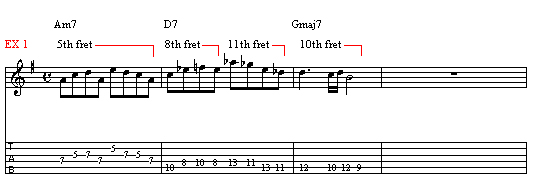Part One: Melody
Focuses on single note soloing. Learn how to effortlessly solo through complex chord changes.
Free Jazz Guitar Lessons with Chris Standring
If you refer back to a previous lesson (entitled "Take
That Scale And Shove It!") I talked about improvising over
a 2, 5, 1 chord sequence, shifting a minor pentatonic scale up a minor
3rd in order to play altered sounds on the dominant chord. Today I would
like to take that concept further and discuss the idea of shifting the
same scale up yet another minor 3rd to hit more altered dominant sounds.
O.K. Once again hit position 5 on your fretboard, the A minor pentatonic
position. Play a line (this time let's use 16th notes to give a funky
time-feel), then move to position 8 (C minor pentatonic) and play the
line again, or variation thereof. Go up yet another minor 3rd to the
Eb minor position in the same bar and continue your thematic line (welcome
to the world of tritone substitution!). Finally, resolve your line down
a 1/2 step to position 10 to G major 7 sounds.
Moving up to Eb minor pentatonic for chord 5 gives you b9, 3, b5, #5
and major 7. The major 7 (as opposed to b7) can be justified as a passing
tone where resolution to D natural for the tonic chord works well. (Just
for the record, Eb melodic minor at this position gives you all
the altered dominant sounds!)
Take care resolving chord 1 at position 10. It's a little trickier as
there is no pentatonic shape to visualize. Note resolutions to D, B,
F# and A are strong.
Ex 1: Shows use of minor pentatonic movement.
Ex 2: Shows use of minor pentatonic movement until final resolution
to chord 1. The F natural (9th of Eb minor) smooths out the line.
Ex 3: Pentatonics again. Resolves to the major 7 of G.
Ex 4: Introduction of dorian minor. Why not be creative?




Free online jazz guitar lessons for beginners, intermediates and advanced.
Online jazz guitar instruction from recording artist Chris Standring
Join The Inside Track membership and get access to all Chris Standring's guitar instructional programs, all in one place.
It has been many years since the first edition of Play What You Hear (originally released in 2000). Now volume two is here with new ideas and concepts, complete with audio, video, traditional notation and TAB throughout. High resolution pdf available for printing the entire program. For intermediate and advanced players.
Focuses on single note soloing. Learn how to effortlessly solo through complex chord changes.
Focuses on chord melody. Learn new harmonic devices and understand chords in a whole new way.
Study Chris Standring's six recorded solos, transcribed with audio and high def video.
Copyright © PlayJazzGuitar.com - All Rights Reserved.